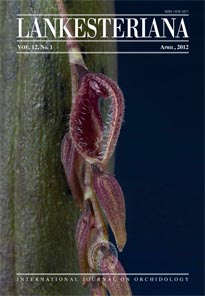On the relationship between bryophyte cover and the distribution of Lepanthes spp. OF LEPanTHES SPP.
DOI:
https://doi.org/10.15517/lank.v12i1.18270Keywords:
bryophyte cover, commensalism, host trees, Lepanthes, microhabitat, orchid distributionAbstract
Epiphytic plant communities in tropical montane ecosystems are particularly vulnerable to climate change. Lepanthes is a large genus of primarily epiphytic orchids that is prominent in the Costa Rican flora. Generally, these orchids are very small and often occur in highly exposed habitats, thus leading to the theory that they are dependent on bryophyte cover to prevent desiccation. Accordingly, the aim of this project was to determine if the distribution of Lepanthes is limited by the distribution of moss cover on trees. To accomplish this, bryophyte cover was measured on phorophytes hosting Lepanthes spp. as well as on other unoccupied trees in the surrounding areas. The results suggest that Lepanthes spp. are correlated with high levels of moss cover and there is often substantially more moss cover at locations where Lepanthes occur than at locations where they do not occur. Accordingly, bryophytes appear to form a commensalism with this diverse group of orchids. The results of this study are in agreement with similar studies that suggest moss cover is important for orchid growth and survival. Consequently, if climate change adversely affects moss coverage on trees, Lepanthes orchids may suffer concomitantly.
Downloads
Downloads
Published
How to Cite
Issue
Section
License
According to the Open Access policy promoted by the University of Costa Rica, all the papers published by Lankesteriana are licensed under the Creative Commons copyright and can be downloaded free of charge. The journal holds copyright and publishing rights under the CC BY-NC-ND 3.0 CR license.
Before the publication of the materials submitted by the author(s) in LANKESTERIANA, the author(s) hereby assign all rights in the article to the Lankester Botanical Garden.








